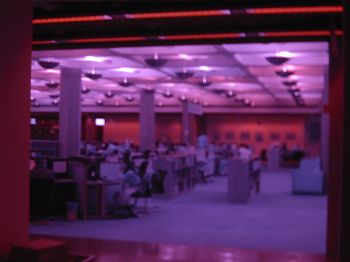
I presumed on this post that I was seeing an intense sodium line from high-pressure sodium lighting while taking daytime near-IR images. What I didn't realize while speculating at that point was that every high-intensity discharge light has a very hot envelope--for high-pressure sodium, a bulb of aluminum oxide (all jokes about transparent aluminum aside, of course). For metal halide and mercury vapor it's usually fused quartz, but sometimes it's the above alumina or sapphire. The tough requirements of dealing with a circa 3500K corrosive plasma dictate the choice of material. Have you ever seen a cycling HPS streetlight? As soon as the arc extinguishes you can see the pure blackbody glow of the very hot bulb window which is at or just below 1200K. That's what I'm detecting in the infrared shots--any HID light that is on is a great IR source. See this shot of the Chicago Theological Union / Oriental Institute or this one on the central quad of the University of Chicago -- the metal halide lights are on in the early evening with sunlight still streaming in. (Don't get me started on energy decisions here). Or here.

Or this HPS streetlight here at Hull Gate.
Compare that with fluorescents: they on the other hand are very poor in near-IR light, as expected from an efficiency standpoint--visible light is what you want in an efficient system. (The HID lights are highly efficient despite emitting copious near-IR light because the arc is incredibly bright and efficient in the visible. But you can't get such efficiencies in a low wattage bulb).
You can see fluorescents glowing a bit in this test focus shot of the first floor of the Reg:

Around the edges of the room are fluorescents, dimly adding some near-IR that is red or very near red. Notice that the ends of the fluorescent tubes are purple: this is further into the IR, and what you're seeing is the thermal glow of the little filaments that heat up and emit electrons. When I need near-IR indoors, I use old-fashioned tungsten: a single 60W incandescent bulb will outlight a room of fluorescents.
No comments:
Post a Comment